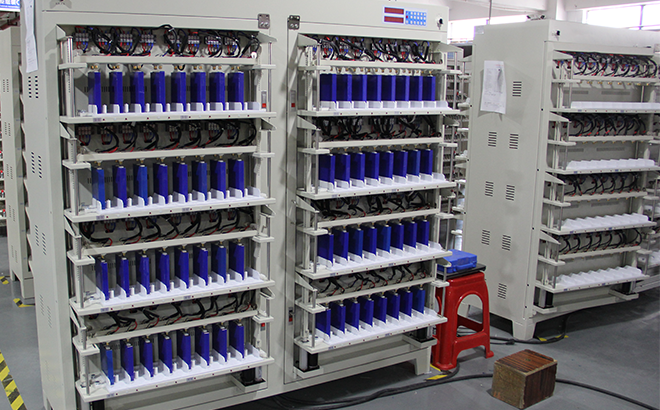Analysis and summary of lithium battery formation-aging process
Dec 30, 2021The production of lithium-ion batteries is a closely linked process of process steps. On the whole, the production of lithium batteries includes pole piece manufacturing process, battery assembly process and the final liquid injection, sealing, formation, and aging process. In the three-stage process, each process can be divided into several key processes, and each step will have a great impact on the final performance of the battery.
In the pole piece manufacturing process, it can be subdivided into five processes: slurry preparation, slurry coating, pole piece rolling, pole piece cutting, and pole piece drying. In the battery assembly process, according to the different battery specifications, it can be roughly divided into winding, casing, welding and other processes. The liquid injection process after the assembly is completed includes liquid injection and sealing. The last is the three-step process of battery formation, aging, and capacity separation. After the battery is manufactured, the battery needs to be pre-activated and stabilized for the first time, that is, the final formation-aging-volumetric process.
1. Formation
The concept of pre-formation is to charge and discharge the manufactured lithium-ion battery with a small current. After the production of the lithium battery is completed, the battery needs to be charged and discharged with a small current. Regarding the purpose of pre-charging, there are mainly two:
1. After the battery is manufactured, the electrode material is not in the best applicable state, or the physical properties are inappropriate (for example, the particles are too large, the contact is not close, etc.), or the phase itself is incorrect (for example, some metal oxide negative electrodes of alloy mechanism) ), it needs to be activated for the first time by charging and discharging.
2. During the first charge of the lithium battery, Li+ is removed from the active material of the positive electrode, and after passing through the electrolyte-diaphragm-electrolyte, it is inserted between the layers of the negative electrode graphite material. During this process, electrons migrate from the positive electrode to the negative electrode along the peripheral circuit. At this time, due to the low potential of lithium ions inserted into the graphite anode, the electrons will first react with the electrolyte to form an SEI film and some gas.
During this process, some gas will be generated and a small amount of electrolyte will be consumed. Some battery manufacturers will perform battery exhaust and refill operations after this process. Especially for LTO batteries, a large amount of gas will be generated and the battery will bulge. The thickness exceeds 10%. For the graphite negative electrode, the amount of gas produced is small, and it is not necessary to perform the operation of exhausting. This is because the SEI film produced during the first charging process hinders the further reaction of electrons with the electrolyte, and no more gas is produced. This is the source of the irreversible capacity of the graphite battery. Although the irreversible capacity loss is caused, the stability of the battery is also achieved.
2. Aging
Aging generally refers to the placement of the battery after the first charging and forming after the battery is assembled and injected. It can be aging at room temperature or high temperature. Both functions are to make the properties and composition of the SEI film formed after the initial charging and forming more stable and ensure The stability of the electrochemical performance of the battery. There are three main purposes of aging:
1. After the battery has undergone the pre-forming process, a certain amount of SEI film will be formed on the graphite negative electrode inside the battery, but this film has a compact structure and small pores. The aging of the battery at high temperatures will help the SEI structure to reorganize and form loose pores the film.
2. The voltage of the battery is in an unstable stage after formation, and its voltage is slightly higher than the real voltage. The purpose of aging is to make its voltage more accurate and stable.
3. Putting the battery under high temperature or normal temperature for a period of time can ensure that the electrolyte can fully infiltrate the pole pieces, which is beneficial to the stability of the battery performance.
The formation and aging process of the battery is indispensable. In actual production, the battery charging and discharging process is selected according to the material system and structural system of the battery, but the formation of the battery must be charged and discharged under the condition of small current. After these two key processes, the stabilized battery is divided into capacity, and after packaging and other processes, it can be released.
ACEY NEW ENERGY has the different channel battery cell capacity grading machine.

